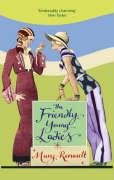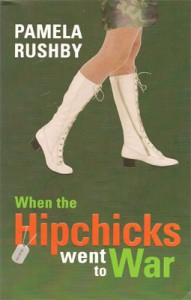Here is a true story about this book. (You know how people say this, then the story turns out to be not very extraordinary at all? This is one of those stories.)
When I was fifteen, my family moved house right at the start of the summer holidays, to yet another country town. I didn’t have any school friends, because I’d just arrived, and there didn’t seem to be anyone of my age left in the surrounding streets – they’d all gone somewhere more interesting for the holidays, and besides, I would have been too shy to approach them if they had been around. As a result, I spent the entire summer in the town library. One day, I came across a dark green paperback with an old-fashioned painting on the front cover and ‘Virago’ written on the spine. I had no idea what ‘Virago’ meant, but I thought I’d give this one a go.
 Well. It was a revelation. The girls in this book weren’t like the girls in any other books I’d read, or even like girls I knew in real life. All the girls I knew thought that the point of life was to make yourself as attractive as possible, so that lots of boys would fall in love with you, whereupon you would choose the most popular boy, fall in love with him, marry him, buy a nice house, fill it with nice objects and have a couple of nice children. I’d never had the slightest interest in doing any of those things, but I’d assumed I would when I finally ‘grew up’. This book dangled in front of me the tantalising possibility that I might grow up and still not want those things. The girls in this book wore whatever they felt like, and sometimes wore nothing at all; had fascinating jobs but no husbands or children; had lots of intriguing, oblique conversations with one another; and lived with their best female friends on houseboats. The word ‘lesbian’ was never mentioned, but I probably wouldn’t have understood it, anyway (it was the eighties, and I was a very unworldly teenager). As it was, quite a lot of the book went over my head, but I didn’t mind. I was absolutely loving swimming around in all that deep, opaque water.
Well. It was a revelation. The girls in this book weren’t like the girls in any other books I’d read, or even like girls I knew in real life. All the girls I knew thought that the point of life was to make yourself as attractive as possible, so that lots of boys would fall in love with you, whereupon you would choose the most popular boy, fall in love with him, marry him, buy a nice house, fill it with nice objects and have a couple of nice children. I’d never had the slightest interest in doing any of those things, but I’d assumed I would when I finally ‘grew up’. This book dangled in front of me the tantalising possibility that I might grow up and still not want those things. The girls in this book wore whatever they felt like, and sometimes wore nothing at all; had fascinating jobs but no husbands or children; had lots of intriguing, oblique conversations with one another; and lived with their best female friends on houseboats. The word ‘lesbian’ was never mentioned, but I probably wouldn’t have understood it, anyway (it was the eighties, and I was a very unworldly teenager). As it was, quite a lot of the book went over my head, but I didn’t mind. I was absolutely loving swimming around in all that deep, opaque water.
I had to return the book eventually, but when I went to look for it a few weeks later, it was gone. Stupidly, I hadn’t written down the author’s name, and I couldn’t even recall the title – something about ladies? I wasn’t quite stupid enough to ask the librarian if she could locate ‘the green book about ladies’, but I made attempts to find it over the next few years, at that library, at other libraries, at various bookshops. Then I gave up and almost (but not quite) forgot about it.
Twenty-five years later, my friend H was on holiday in the UK and browsing through second-hand bookshops.
“Hey,” she e-mailed me. “I found this great book I think you’ll like. It’s really clever and funny, and it’s set in 1930s England, and it says on the back that it’s the antidote to The Well of Loneliness, so I thought of you straight away! Not that you’re anything like The Well of Loneliness.”
“I haven’t ever been able to bring myself to read The Well of Loneliness,” I e-mailed back. “Sounds too depressing.” Then something swam up from the depths of my memory. “Hang on. This book isn’t about two girls living a bohemian existence on a houseboat, is it?”
“Yes, and the little sister of one of them runs away from home and comes to live with them, and there’s this hilariously awful doctor who fancies himself as God’s gift to women and tries to seduce all three of them – for their own good, of course.”
“This book isn’t green, is it?”
“Yes, and it’s got a lovely painting of two girls in 1930s clothes on the cover.”
“And is there a scene where the little sister gets badly sunburnt, so they use green face powder to disguise it?” (For some reason, this was the scene that had stuck with me. Green face powder. Would that really work?)
“Maybe,” she said. “Haven’t got up to that bit yet. I’ll send it to you when I’ve finished.”
And it was the very same book – well, the cover was different, but it was still green. It was Mary Renault’s 1944 novel, The Friendly Young Ladies, and it was just as good as I’d remembered. Lots of sharp social satire, and some wonderful insights into the convoluted thoughts and emotions of the characters. For example, here’s the self-satisfied doctor, who sees himself as a saviour of lonely female patients:
“His dislike of hurting anyone was entirely genuine, as traits which people use for effect often are; and from this it followed that if anyone insisted on being hurt by him, he found the injury hard to forgive.”
There are also some funny, irreverent comments about writing and publishing. One character, who writes cowboy books, describes herself cheerfully as a “competent hack” and says,
“Personally I always think people are rather sickening who make out they could write better than they do. It’s like losing a game and then saying you didn’t try.”
And here she is, complaining about an editor who says he wants to see more romance in her manuscript:
“I did put a girl in. I’m sure I did. Her name was Susie, or Sadie, or something. And I mentioned her again at the end . . . I always think it would save such a lot of trouble if you could just indicate it with a row of crosses, or BERT LOVES MABEL, or something quick, and get on with the story.”
So, lots to enjoy – except for the conclusion, which I’d forgotten entirely. And this brings me to why this book is ‘dated’.
As with The Charioteer, there are no descriptions of any form of sex. In an afterword, written forty years after the book was first published, Renault says,
“I have sometimes been asked whether I would have written this book more explicitly in a more permissive decade. No; I have always been as explicit as I wanted to be, and have not been much more so in recent books. If characters have come to life, one should know how they will make love; if not it doesn’t matter.”
That’s interesting, although I don’t agree with her. By her argument, if the characters have come to life in the first half of the book, then the reader ought to know how they’ll interact in the second half, so why bother writing the rest?
Renault also criticises the “silliness of the ending” of this book. She’s quite right, it is extremely silly, although so are some other aspects of the plot. As a discussion of this involves plot spoilers, I’ve hidden the next three paragraphs. Use your mouse to highlight the blank space (or use your browser to ‘select all’ text) if you’d like to read on.
It turns out Leonora, the tomboyish elder sister of runaway Elsie, had an unsatisfying sexual experience with her friend Tom when they were both teenagers. As a result, Leo has turned to women, and eventually ends up in a happy, satisfying, long-term partnership with the beautiful, talented Helen, who loves Leo devotedly but not possessively. It seems an ideal relationship, supportive without being suffocating. Leo is also close friends with Joe, who lives up the river from them. He’s handsome, clever, sensitive, a brilliant writer, from a wealthy family but not at all snobbish, able to fish, paddle a canoe, climb mountains, rescue drowning women and build houses with his bare hands. And, in the final chapters, he ‘cures’ Leo of her lesbianism by having (dubiously consensual) sex with her. Then Leo abandons Helen and goes off with him to America.
I mean, what?!
Renault thinks the conclusion is silly because Leo and Joe would have a chaotic domestic life, and this would prevent Joe from writing. I think it’s silly because Leo’s previous unsatisfactory heterosexual experiences are due to her being a lesbian, not the other way around, and that Leo abandoning Helen makes absolutely no sense.
Despite the conclusion, I think this is a terrific read. If you’re interested, Charles Taylor has written a very thoughtful review of the book.
More ‘dated’ books:
1. Wigs on the Green by Nancy Mitford
2. The Charioteer by Mary Renault
3. The Friendly Young Ladies by Mary Renault
4. Police at the Funeral by Margery Allingham
5. Emil and the Detectives by Erich Kästner
6. The Wind in the Willows by Kenneth Grahame
7. Swallows and Amazons by Arthur Ransome
8. Kangaroo by D. H. Lawrence




